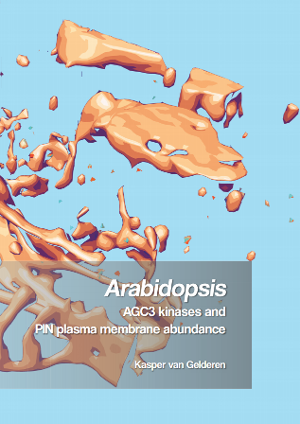Proefschrift
Arabidopsis AGC3 kinases and PIN plasma membrane abundance
The plant hormone auxin plays a central role in the growth and development of plants. Auxin acts in a concentration dependent manner and polar cell-to-cell transport of this hormone determines its distribution in the tissues of plants. This polar auxin transport is mediated by several families of auxin transporters, including the PIN FORMED (PIN) auxin efflux carriers that determine the direction of transport by their polar localization at the plasma membrane.
- Auteur
- Kasper van Gelderen
- Datum
- 06 juli 2017
- Links
- Thesis in Leiden Repository

The plasma membrane abundance and polarity of PINs (and thereby of polar auxin transport) is regulated by their post-translational modification, of which phosphorylation is best studied. PIN proteins in Arabidopsis consist of two transmembrane domains separated by a ‘long’ (PIN1,2,3,4,6,7) or by a ‘short’ (PIN5,8) hydrophilic loop. Phosphorylation of ‘long’ PINs in their central hydrophilic loop by the AGC3 kinases PINOID, WAG1 and WAG2 triggers shootward (apical) or outer-lateral polarity. The AGC1- type D6 kinases also phosphorylate the PIN hydrophilic loop, however this was reported to result in auxin transport activation rather than subcellular polarity establishment. Here we investigate the conservation and phylogeny of AGC3 and D6 kinases and their phosphorylation sites in PINs from the earliest land plants to flowering plants. In early land plants, many of the same proteins and conserved motifs can be found, however it is in monocots and dicots that conservation of PIN phosphorylation by AGC3 and D6 kinases is strongest. The expansion and increased conservation of AGC3 and D6 kinases and PINs in later lineages such as monocot and dicot flowering plants, is in line with their important role in the formation of reproductive organs and in the tropic growth responses that allow plants to adapt to changes in their environment.
